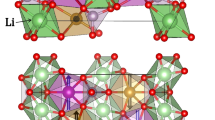Abstract
Tris(2,2'-bipyridyl)-57CoII and bis(2,2':6',2'-terpyridine)-57CoII complexes were synthesised in the supercages of zeolite‐Y in order to study the effect of molecular isolation on the aftereffects of the 57Co(EC)57Fe decay. As compared to the regular crystalline salts of the complex ions where, according to the emission Mössbauer spectra, the most abundant species is low‐spin FeII, the molecular isolation in the zeolite resulted in a larger fraction of low‐spin FeIII and a varying amount of high‐spin Fe2+ species. In the investigated temperature range, 20 K to 295 K, the majority of the changes was observed above 80 K. In the case of tris (2,2'-bipyridyl)-57CoII-Y, the most characteristic change occurred in valence states, while for bis (2,2':6',2'-terpyridine)-57CoII‐Y, the temperature dependence of the spin states was more prominent. The change in the low spin valence states is explained partly by donor-acceptor properties of the zeolite lattice. The variation in the high spin fraction is explained by radiation damage of the ligand sphere and/or fragmentation of the complex ion followed by incomplete recombination in the supercage. Molecular isolation itself did not seem to increase the chance of fragmentation (as a consequence of charge neutralization following Auger ionization) of these highly conjugated complex molecules.
Similar content being viewed by others
References
H. Sano and P. Gütlich, Hot atom chemistry in relation to Mössbauer emission spectroscopy, in: Hot Atom Chemistry, ed. T. Matsuura (Kodanski, Tokyo, 1984) p. 265.
H. Pollak, Phys. Status Solidi 2 (1962) 270.
A. Nath, M.P. Klein and W. Kündig, Chem. Phys. Lett. 2 (1968) 471.
A. Nath, M.P. Klein, W. Kündig and D. Lichtenstein, Radiation Effects 2 (1970) 211.
E.M. Baggio-Saitovitch, J.M. Friedt and J. Danon, J. Chem. Phys. 56 (1972) 1269.
M.I. Afanasov, Yu.D. Perfiliev and A.N. Babeshkin, J. Radioanal. Chem. 27 (1975) 125.
T.S. Srivastava and A. Nath, J. Phys. Chem. 80 (1976) 529.
M.I. Afanasov, L.A. Kulikov and A.N. Babeshkin, Radiochem. Radioanal. Lett. 57 (1983) 247.
A. Nath, Ch. Sauer and A. Halpern, J. Chem. Phys. 78 (1983) 5125.
J.M. Friedt and J.P. Adloff, C.R. Acad. Sci. Paris 264 (1967) 1356.
P. Gütlich, S. Odar, B.W. Fitzsimmons and N.E. Erickson, Radiochim. Acta 10 (1968) 147.
E.F.T. Lee and L.V.C. Rees, Zeolites 7 (1987) 143.
W.H. Quayle, G. Peeters, G.L. De Roy, E.F. Vansant and J.H. Lunsford, Inorg. Chem. 21 (1982) 2226.
S. Deisenroth, A. Hauser, H. Spiering and P. Gütlich, Hyp. Interact. 93 (1994) 1573.
S. Deisenroth, H. Spiering, D. Schollmeyer, D.L. Nagy and P. Gütlich, in: ICAME '95, Conf. Proceedings, Vol. 50, ed. I. Ortalli (SIF, Bologna, 1996) p. 23.
Rights and permissions
About this article
Cite this article
Homonnay, Z., Vankó, G., Vértes, A. et al. Aftereffects in zeolite‐encapsulated 57Co‐complexes. Hyperfine Interactions 113, 331–339 (1998). https://doi.org/10.1023/A:1012640119963
Issue Date:
DOI: https://doi.org/10.1023/A:1012640119963




